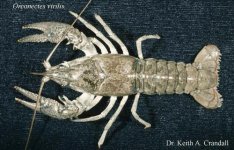I have been catching crayfish to eat since I moved to Utah in 1970 so I have a lot if interest in them.
35 years ago at Powell we would walk the shoreline at night with flashlights and see lots of crayfish out and about and we could turn over rocks and catch some. There would also be lots of activity around fish carcasses tossed in the lake, there were so many they would drag the carcasses away to even deeper water and by morning they were all gone. They seemed to be a little larger back then, but not that much. Even then we would never have much luck catching them with traps at Lake Powell. In more recent years on many trips I have looked and see very few if any, yet they are always present in fish stomachs. I think the smallmouth are so efficient at eating them they keep the numbers in check. It seems there are less around since the SMB became more prolific in the lake. Wayne would have more expertise on this, but I think the type of crayfish in Powell is different from the ones in Strawberry, Scofield etc. I have been told those are non native and were brought in years ago either accidentally with warm water fish from other states or on purpose as food for fish and then moved around illegally?? I can remember when there were not any of the bigger crayfish in Strawberry at all. I attended a meeting back in the eighty's if I remember correctly when the DWR changed the rules on transporting Crayfish alive to limit them being moved around. They had a map showing where they were spreading to, but that they were not in Strawberry yet. I told them at the time that they were already there but you could only find them near the boat ramps, (go figure) now of course they are everywhere.
On a side note we used to catch lots of them in traps at Deer Creek years ago, now they seem to be very few, the introduction on SMB and Walleye I think have kept the numbers down from where they used to be......
Mildog out

